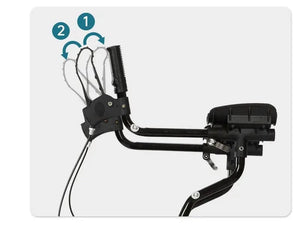Why Elenker Rollator Walkers Are Safe on Slopes
Jun 27, 2025
Okay, so you’ve got an Elenker rollator walker, and now there’s a hill or ramp staring you down. You might be wondering, “Can I actually trust this thing to keep me steady up and down slopes?” Fair question! Slopes can definitely make things a bit trickier, but I’m here to tell you Elenker rollators handle them pretty well.
Walkers with Big Wheels Make a Big Difference
First off, those wheels. Elenker walkers usually have wheels that are bigger and tougher than what you’d find on basic models. Why does that matter? Because bigger wheels roll over bumps, cracks and uneven pavement like a champ. On a slope, that means fewer surprises — no sudden jerks or catches that throw you off balance.
Plus, those wheels grip better. So if the ramp’s a little wet or rough, you’re less likely to slip or skid. It’s kind of like giving your walker sneakers with good tread instead of flip-flops.

Elenker YF-9008C upright walker with 10" non-slip tread wheels
Brakes on Walkers That Don’t Quit on You
Slopes without brakes? Nope, not a good combo. One of the best parts about Elenker walkers is their brakes — they’re pretty easy to use but strong enough to hold you safely on a hill.
Going downhill, you don’t have to worry about your walker zooming away. You just gently squeeze the brakes and keep your pace nice and steady. When you want to stop, those brakes lock up tight, so you’re not rolling backwards.

Dual Brakes: (1) squeeze to slow down and (2) press down to lock the wheels
If you haven’t tested the brakes on an incline yet, maybe try it out on a gentle ramp first. Getting a feel for how they respond can really boost your confidence.
Walkers with Solid Frame Means Less Wobble
Elenker rollators don’t feel flimsy. They’re built to be solid and steady, which is exactly what you want on slopes. When the ground’s tilting, your body has to keep adjusting — and a walker that wobbles or tips isn’t going to help.

Elenker YF-9008C upright walker with solid frame
With Elenker, you get that sturdy support that feels like a good friend backing you up. It helps you focus more on your steps and less on whether your walker is going to tip over.
Adjusting to You, Not the Other Way Around
Everyone’s different - height, stride, strength - and slopes mess with your natural rhythm. Luckily, Elenker walkers often have adjustable handles, so you can set them just right for your comfort.
This means when you lean forward going uphill or shift your weight going downhill, you don’t feel awkward or cramped. Your posture feels natural, which makes your whole walk smoother and safer.

You can adjust your handle bar height for better posture
Climbing Hills Without Feeling Beat
Pushing up a hill can be a workout, no doubt. But Elenker’s smooth wheels and sturdy frame help keep things manageable. Lean a little forward, push steadily and let the walker do its thing. It’s all about working smarter, not harder.
And hey, if you get tired, no shame in taking a seat. Some Elenker models come with a handy seat, so you can rest whenever you need.
But Here’s a Crucial Safety Tip About That Built-in Seat
One important thing to remember: sitting on your rollator seat while on a slope — especially a steep one — isn’t the safest idea. The angle can make the walker unstable, and you risk tipping over or sliding. It’s best to only use the seat on flat, level ground where you know you’re steady. So save those comfy sits for when the ground is nice and even.

Sit when the ground is nice and even
Taking the Scary Out of Going Downhill
Going downhill can freak people out. Gravity pulling you forward feels a little like you’re on a rollercoaster you didn’t sign up for.
With Elenker, you can keep your speed in check thanks to those trusty brakes and good wheel traction. The design helps you keep your weight balanced, so you’re not leaning too far forward or backward. Taking small, controlled steps feels a lot safer than just rushing down.
Surface Matters (Always)
No walker can fix slick ice or loose gravel. Elenker’s bigger wheels give you a leg up, but slippery or uneven slopes still demand extra caution.
If the ramp looks wet or covered with leaves, it’s smart to slow down or maybe take a different path. Safety first, always.
Getting the Hang of It
If slopes are new territory, start slow. Find a gentle ramp and get a feel for how your walker handles it. Play with the brakes a little, adjust your posture, and build that muscle memory.
Having someone nearby for support or advice helps, too. Sometimes a quick tip from a friend or a physical therapist can make all the difference.
When to Sit It Out
Sometimes slopes just aren’t the right call — especially if your brakes aren’t working right or if you’re feeling unsteady. It’s okay to step back, find an easier way, or get some help. No need to push it.
Bottom Line
Elenker rollator walkers are solid companions for slopes, thanks to their bigger wheels, reliable brakes and sturdy design. They’re built to keep you balanced and safe while giving you the freedom to tackle ramps and gentle hills.
With a little practice and care — and remembering to only sit on level ground — those slopes won’t feel quite so intimidating. So take it easy, trust your rollator, and keep moving with confidence.











